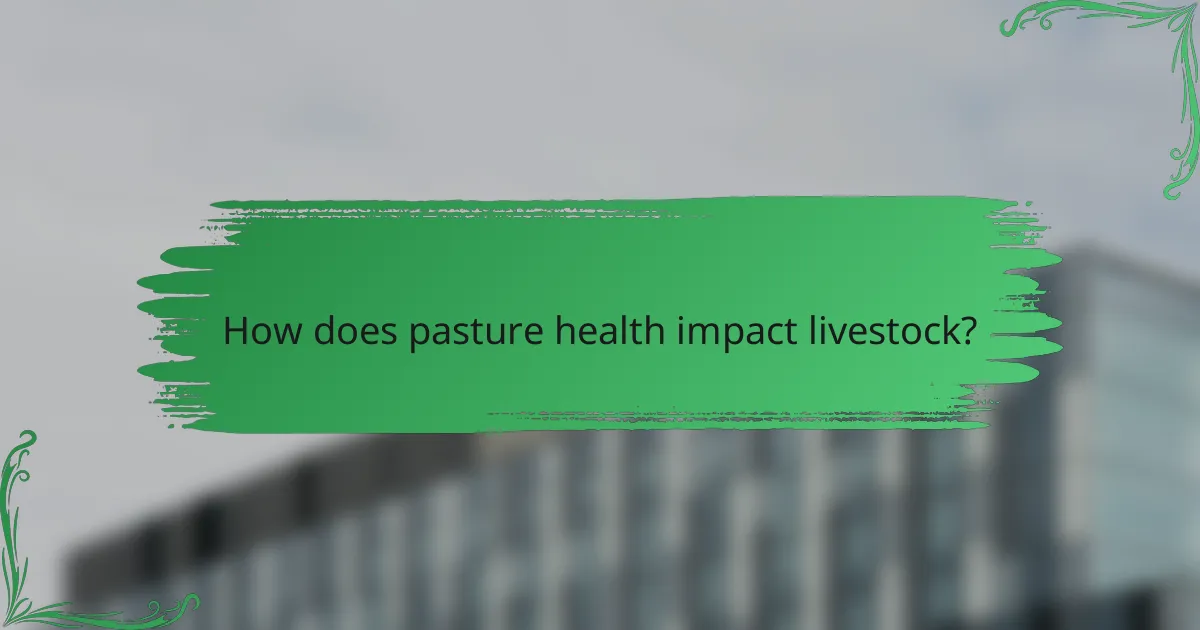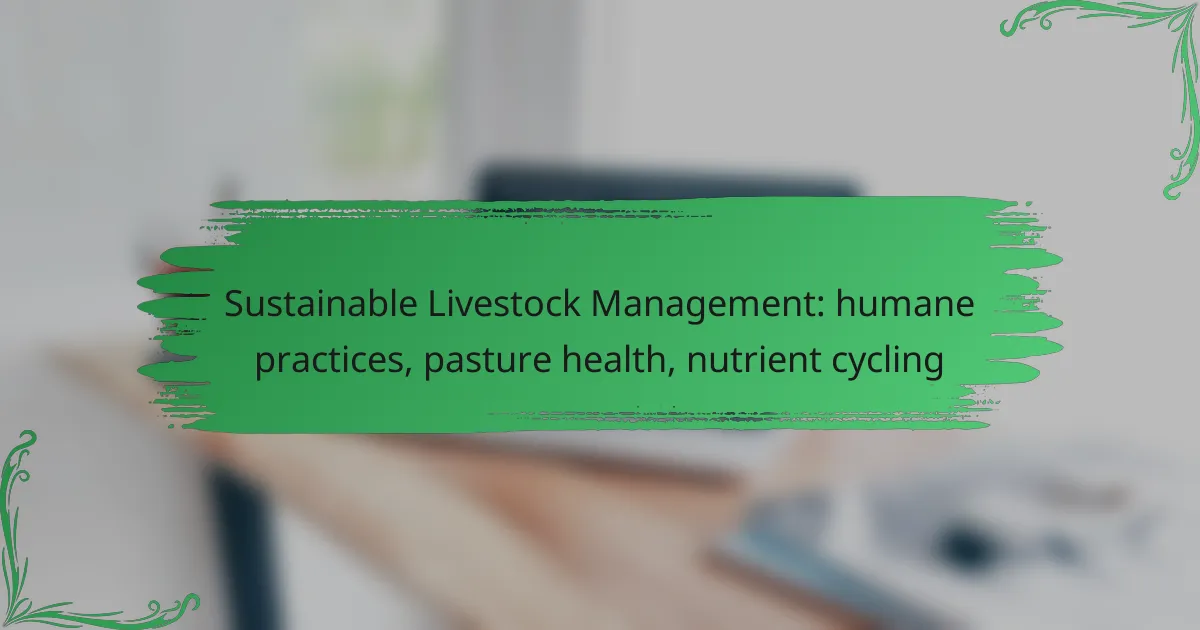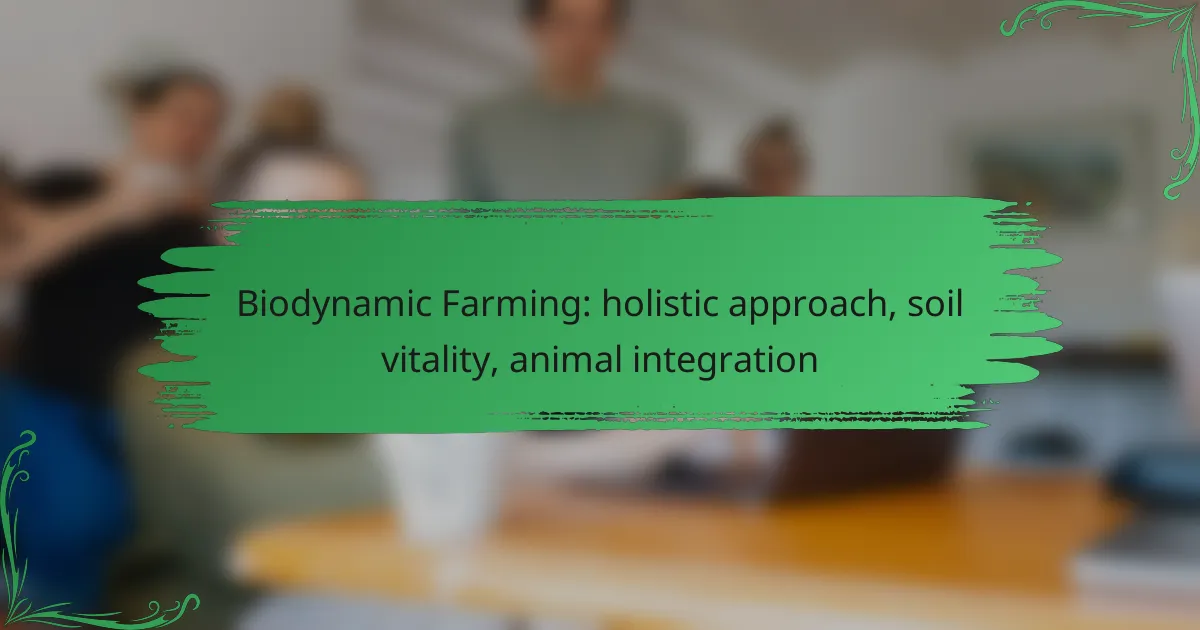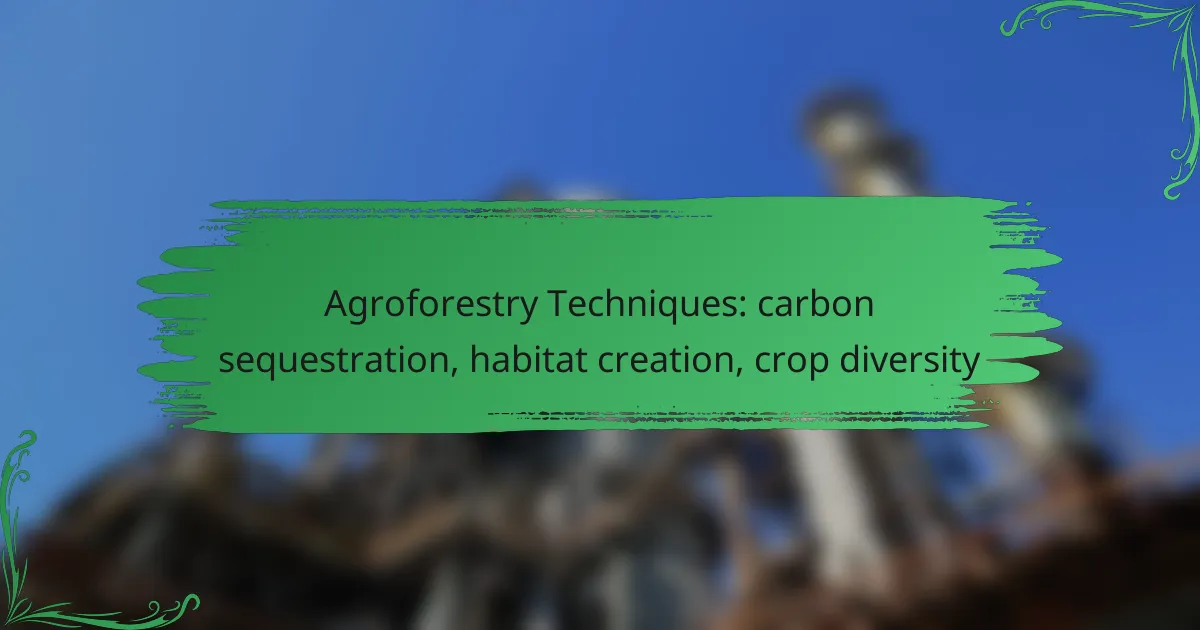Sustainable livestock management integrates humane practices that prioritize animal welfare while fostering environmental health. By focusing on pasture health and nutrient cycling, these methods enhance livestock productivity and well-being, creating a balanced ecosystem that benefits both animals and the land. Effective nutrient recycling ensures essential elements are reused, promoting soil fertility and reducing reliance on synthetic fertilizers.

What are humane practices in sustainable livestock management?
Humane practices in sustainable livestock management focus on ensuring the well-being of animals while promoting environmental health. These practices prioritize animal welfare, low-stress handling, and enrichment strategies to create a balanced ecosystem that benefits both livestock and pasture health.
Animal welfare standards
Animal welfare standards are guidelines that ensure livestock are treated with respect and care throughout their lives. These standards often include proper housing, access to food and water, and veterinary care. Adhering to recognized standards, such as those set by the Global Animal Partnership or the Animal Welfare Approved program, can help farmers maintain ethical practices.
Farmers should regularly assess their operations against these standards to identify areas for improvement. Implementing welfare-friendly practices can enhance animal health and productivity, ultimately benefiting the farm’s sustainability.
Low-stress handling techniques
Low-stress handling techniques are methods used to minimize fear and anxiety in livestock during management activities. Approaches such as using calm voices, gentle movements, and proper equipment can significantly reduce stress. For instance, using curved chutes can help guide animals more naturally, leading to smoother handling experiences.
Training staff in these techniques is essential to ensure consistency and effectiveness. Reducing stress not only improves animal welfare but can also enhance productivity and meat quality, making it a win-win for farmers.
Enrichment strategies
Enrichment strategies involve providing livestock with opportunities to engage in natural behaviors, which can improve their overall well-being. This can include providing varied diets, social interactions, and environmental enhancements like toys or structures for exploration. For example, pigs benefit from rooting opportunities, while chickens enjoy perches and dust baths.
Implementing enrichment can lead to healthier animals and better production outcomes. Farmers should regularly evaluate their enrichment practices to ensure they meet the needs of their livestock, adjusting as necessary to promote optimal welfare and productivity.

How does pasture health impact livestock?
Pasture health significantly influences livestock productivity and well-being. Healthy pastures provide essential nutrients, improve animal welfare, and enhance overall farm sustainability.
Soil fertility and biodiversity
Soil fertility is crucial for maintaining healthy pastures, as it directly affects plant growth and nutrient availability. Practices such as crop rotation, cover cropping, and organic amendments can enhance soil health and biodiversity, leading to more resilient ecosystems.
A diverse pasture ecosystem supports a variety of plant species, which can improve forage quality and provide habitats for beneficial insects and microorganisms. This biodiversity can also reduce the need for chemical fertilizers and pesticides, promoting a more sustainable approach to livestock management.
Forage quality and availability
Forage quality is vital for livestock health and productivity. High-quality forage contains adequate protein, energy, and minerals, which are essential for growth, reproduction, and milk production. Regularly assessing forage quality helps farmers make informed decisions about grazing management and supplementation.
To ensure forage availability, rotational grazing can be an effective strategy. This practice allows pastures to recover and regenerate, providing a consistent supply of nutritious forage throughout the grazing season. Farmers should monitor pasture conditions and adjust grazing intensity accordingly to prevent overgrazing.
Water management practices
Effective water management is essential for maintaining pasture health and livestock welfare. Access to clean, fresh water supports animal hydration and encourages grazing, which is vital for nutrient intake. Implementing water troughs and ensuring proper drainage can enhance water availability in pastures.
Additionally, managing water runoff and preventing soil erosion are critical for maintaining pasture quality. Techniques such as contour farming, buffer strips, and strategic planting can help retain moisture and improve soil structure, ultimately benefiting both livestock and pasture health.

What is nutrient cycling in livestock systems?
Nutrient cycling in livestock systems refers to the process of recycling nutrients through various biological and physical mechanisms, ensuring that essential elements like nitrogen, phosphorus, and potassium are reused effectively. This practice enhances soil fertility, promotes pasture health, and supports sustainable livestock management by minimizing waste and reducing the need for synthetic fertilizers.
Role of manure in soil health
Farmers should consider the timing and method of manure application to maximize its benefits. For instance, applying manure during the growing season can provide immediate nutrients to crops, while incorporating it into the soil can reduce nutrient runoff and improve absorption.
Integrating crop and livestock systems
Integrating crop and livestock systems enhances nutrient cycling by allowing for the efficient use of resources. Livestock can graze cover crops, which helps control weeds and provides organic matter through manure, while crops can benefit from the nutrients deposited by livestock. This symbiotic relationship reduces the reliance on chemical fertilizers and promotes a more sustainable agricultural practice.
Farmers should plan crop rotations and grazing schedules carefully to optimize nutrient flow. For example, rotating livestock through different pastures can prevent overgrazing and allow for natural regeneration of soil nutrients.
Composting techniques
Composting is an effective method for recycling nutrients from livestock waste, transforming it into a valuable soil amendment. Proper composting techniques involve balancing carbon-rich materials (like straw) with nitrogen-rich manure, maintaining adequate moisture, and ensuring sufficient aeration. This process not only reduces pathogens but also enhances nutrient availability in the final product.
Farmers can use a simple composting system by layering materials and turning the pile regularly to promote decomposition. A well-managed compost can be ready for application in a few months, providing a rich source of nutrients for crops and pastures while reducing waste disposal issues.

How can farmers implement sustainable practices in the UK?
Farmers in the UK can implement sustainable practices by adopting methods that enhance animal welfare, improve pasture health, and promote nutrient cycling. This involves integrating humane livestock management techniques with regenerative agricultural practices to create a balanced ecosystem.
Regenerative agriculture methods
Regenerative agriculture focuses on restoring soil health and increasing biodiversity while maintaining livestock productivity. Techniques such as rotational grazing, cover cropping, and agroforestry help improve pasture quality and reduce reliance on chemical inputs. Farmers can start by rotating grazing areas to prevent overgrazing and allow pastures to recover.
Additionally, incorporating legumes into pastures can enhance nitrogen fixation, improving soil fertility naturally. This method not only supports livestock nutrition but also contributes to a healthier ecosystem.
Government incentives and support
The UK government offers various incentives to encourage sustainable farming practices, including grants for implementing regenerative agriculture methods. Programs like the Environmental Land Management scheme provide financial support for farmers who adopt practices that enhance environmental sustainability.
Farmers should explore local initiatives and funding opportunities that align with their sustainability goals. Engaging with agricultural advisors can help identify the most beneficial programs and ensure compliance with regulations.
Case studies of successful farms
Several farms in the UK have successfully implemented sustainable practices, showcasing the viability of these methods. For example, a farm in Devon adopted rotational grazing and saw a significant improvement in pasture health and livestock productivity, leading to higher profits and reduced feed costs.
Another case study from Scotland highlights a farm that integrated agroforestry, resulting in increased biodiversity and improved soil quality. These examples illustrate that sustainable practices can lead to both environmental benefits and economic viability for farmers.

What are the benefits of sustainable livestock management?
Sustainable livestock management offers numerous benefits, including improved animal welfare, enhanced pasture health, and effective nutrient cycling. These practices not only support the environment but also contribute to economic stability and community well-being.
Improved economic viability
Sustainable livestock management can lead to better economic outcomes for farmers. By adopting practices such as rotational grazing and integrated pest management, producers can reduce feed costs and improve livestock productivity. This approach often results in lower input costs and higher profit margins over time.
Farmers can also benefit from accessing premium markets that prioritize humane and sustainable practices. This can translate to higher prices for products, as consumers increasingly seek ethically sourced meat and dairy options.
Enhanced ecosystem services
Implementing sustainable livestock practices enhances ecosystem services, such as soil health and biodiversity. Practices like rotational grazing help maintain pasture quality, promote nutrient cycling, and prevent overgrazing, which can lead to soil degradation.
Moreover, well-managed pastures can sequester carbon, contributing to climate change mitigation. By fostering a diverse range of plant species, sustainable livestock systems can improve habitat for wildlife and enhance overall ecosystem resilience.
Community health and food security
Sustainable livestock management positively impacts community health and food security by ensuring a stable supply of nutritious food. By prioritizing local production, communities can reduce reliance on imported goods, which can be subject to fluctuations in price and availability.
Additionally, these practices promote better animal welfare, leading to healthier livestock and safer food products. This can reduce the risk of foodborne illnesses and enhance public health outcomes, contributing to a more secure food system for all.

What frameworks support sustainable livestock practices?
Sustainable livestock practices are supported by various frameworks that promote humane treatment, pasture health, and nutrient cycling. These frameworks include certification programs, guidelines, and standards that help farmers implement effective and ethical practices.
Certification programs
Certification programs play a crucial role in promoting sustainable livestock management by establishing standards for humane treatment and environmental stewardship. These programs often require farmers to adhere to specific practices that enhance animal welfare, pasture health, and nutrient cycling.
Examples of well-known certification programs include Animal Welfare Approved, Certified Humane, and Global Animal Partnership. Each of these programs has its own set of criteria, which may cover aspects like pasture access, feed quality, and overall animal care.
Farmers interested in certification should carefully review the requirements of each program and consider the costs associated with compliance. While certification can enhance marketability and consumer trust, it may also involve significant investment in training and infrastructure.



